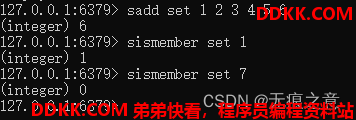1 sismemberCommand
1.1 方法说明
判断一个值是否属于集合的成员,成功返回1,失败返回0。
1.2 命令实践

1.3 方法源代码
void sismemberCommand(redisClient *c) {
robj *set;
//获取集合键对象
if ((set = lookupKeyReadOrReply(c,c->argv[1],shared.czero)) == NULL ||
checkType(c,set,REDIS_SET)) return;
c->argv[2] = tryObjectEncoding(c->argv[2]);
//判断一个元素是否属于对象
if (setTypeIsMember(set,c->argv[2]))
addReply(c,shared.cone);
else
addReply(c,shared.czero);
}
int setTypeIsMember(robj *subject, robj *value) {
long long llval;
//如果是哈希表
if (subject->encoding == REDIS_ENCODING_HT) {
return dictFind((dict*)subject->ptr,value) != NULL;
}
//如果是整数集合
else if (subject->encoding == REDIS_ENCODING_INTSET) {
if (isObjectRepresentableAsLongLong(value,&llval) == REDIS_OK) {
return intsetFind((intset*)subject->ptr,llval);
}
} else {
redisPanic("Unknown set encoding");
}
return 0;
}
1.4 代码理解
1、 先获取集合键对象,并检查对象类型;
2、 调用setTypeIsMember判断元素是否属于集合中;
2 scardCommand
2.1 方法说明
获取集合元素的个数。
2.2 命令实践

2.3 方法源代码
void scardCommand(redisClient *c) {
robj *o;
//获取键,并判断键类型
if ((o = lookupKeyReadOrReply(c,c->argv[1],shared.czero)) == NULL ||
checkType(c,o,REDIS_SET)) return;
//获取集合的长度
addReplyLongLong(c,setTypeSize(o));
}
unsigned long setTypeSize(robj *subject) {
//如果是哈希表
if (subject->encoding == REDIS_ENCODING_HT) {
return dictSize((dict*)subject->ptr);
}
//如果是整数集合
else if (subject->encoding == REDIS_ENCODING_INTSET) {
return intsetLen((intset*)subject->ptr);
} else {
redisPanic("Unknown set encoding");
}
}
2.4 代码理解
1、 先获取集合键对象,并检查对象类型;
2、 调用setTypeIsMember判断元素是否属于集合中;
3 spopCommand
3.1 方法说明
从集合中随机弹出一个元素,成功返回弹出的元素。
3.2 命令实践

3.3 方法源代码
void spopCommand(redisClient *c) {
robj *set, *ele, *aux;
int64_t llele;
int encoding;
//获取集合键对象,并判断类型
if ((set = lookupKeyWriteOrReply(c,c->argv[1],shared.nullbulk)) == NULL ||
checkType(c,set,REDIS_SET)) return;
//随机获取集合中的一个元素
encoding = setTypeRandomElement(set,&ele,&llele);
//从集合中删除这个元素
if (encoding == REDIS_ENCODING_INTSET) {
ele = createStringObjectFromLongLong(llele);
set->ptr = intsetRemove(set->ptr,llele,NULL);
} else {
incrRefCount(ele);
setTypeRemove(set,ele);
}
//触发通知事件
notifyKeyspaceEvent(REDIS_NOTIFY_SET,"spop",c->argv[1],c->db->id);
/* Replicate/AOF this command as an SREM operation */
aux = createStringObject("SREM",4);
rewriteClientCommandVector(c,3,aux,c->argv[1],ele);
decrRefCount(ele);
decrRefCount(aux);
addReplyBulk(c,ele);
//如果集合中没有元素,则删除集合键
if (setTypeSize(set) == 0) {
dbDelete(c->db,c->argv[1]);
notifyKeyspaceEvent(REDIS_NOTIFY_GENERIC,"del",c->argv[1],c->db->id);
}
//标记键被修改
signalModifiedKey(c->db,c->argv[1]);
server.dirty++;
}
/* Return random element from a non empty set.
* The returned element can be a int64_t value if the set is encoded
* as an "intset" blob of integers, or a redis object if the set
* is a regular set.
*
* The caller provides both pointers to be populated with the right
* object. The return value of the function is the object->encoding
* field of the object and is used by the caller to check if the
* int64_t pointer or the redis object pointer was populated.
*
* When an object is returned (the set was a real set) the ref count
* of the object is not incremented so this function can be considered
* copy on write friendly. */
int setTypeRandomElement(robj *setobj, robj **objele, int64_t *llele) {
if (setobj->encoding == REDIS_ENCODING_HT) {
dictEntry *de = dictGetRandomKey(setobj->ptr);
*objele = dictGetKey(de);
} else if (setobj->encoding == REDIS_ENCODING_INTSET) {
*llele = intsetRandom(setobj->ptr);
} else {
redisPanic("Unknown set encoding");
}
return setobj->encoding;
}
3.4 代码理解
1、 获取集合键对象,并判断类型;
2、 调用setTypeRandomElement方法随机获取集合中的一个元素;
3、 根据数据结构调用相应的方法,删除这个元素;
4、 触发spop类型触发事件;
5、 如果集合中没有元素的话,则需要将集合删除,并触发del类型触发事件;
6、 标记键被修改;
4 总结
1、 spop是从集合中随机弹出一个元素;